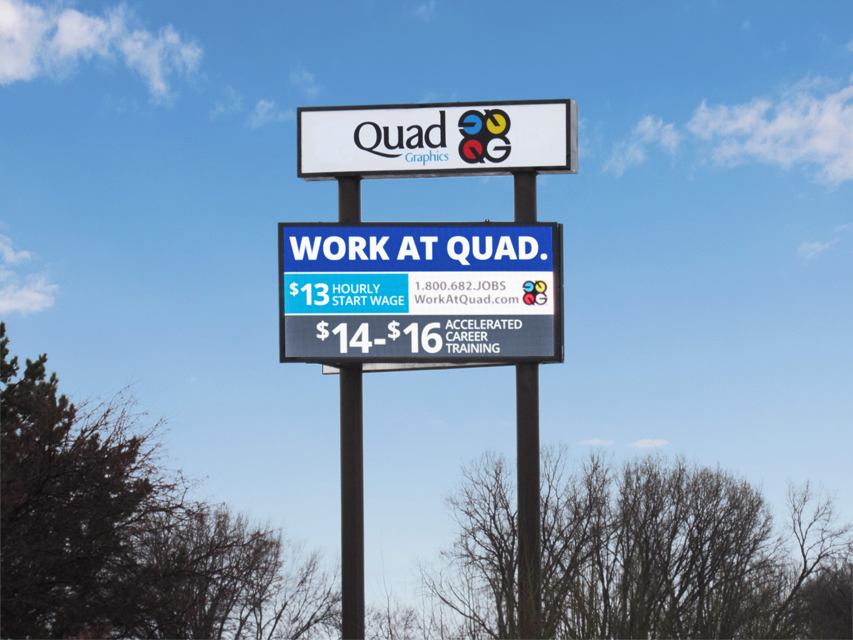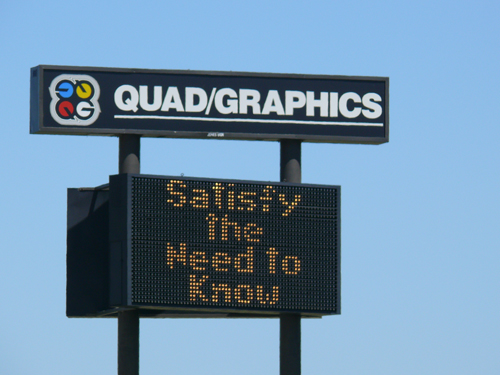
Here’s the story of one company that, several years ago, replaced its old incandescent bulb message center sign with static flex faces. Yet realizing they needed some extra oomph to get the job done, they dynamically came back full-circle with the installation of a brand-new, state-of-the-art digital message center.
Starting out with a single rented printing press back in 1917, Quad/Graphics has evolved today into a global multichannel solutions provider that prints magazines, catalogs, and retail inserts. Its Lomira, Wisconsin location is the largest print-production facility in the Western Hemisphere (2 million-plus square feet).
An early adopter of electronic message centers (EMCs), the Lomira plant has one of the largest pylon signs on highway U.S. 41, which is the main thoroughfare connecting Green Bay to Milwaukee. But when the aging incandescent bulb EMC they’d been using since 1999 began to fail, the company decommissioned it back in 2014 and covered it with flex faces featuring the words “Now Hiring.”
However this static, non-illuminated flex face solution was woefully underperforming, particularly when it came to posting employment recruitment notices.
Quad/Graphics figured they would yield a better return on investment if they went back to an EMC.
They reached out to their long-time sign partner TLC Sign in Kimberly, Wisconsin for suggestions. TLC Sign is a family-owned, full-service sign business that’s been open for twenty-four years. While they’ve made a name for themselves in the area with their success at heavy installs, their twenty-five team members do everything from cut vinyl and vehicle wraps to lighting and digital signage.
“Quad/Graphics originally had a 30R20 bulb incandescent message center and would service and repair it or replace the lamps that had failed over the years,” says TLC Sign Owner Tim Cullen, noting that they were ahead of the curve because they wouldn’t need a new host structure as the viewing angles had already been set with the old message center. “Our customer and teammates, Joel Gidder and Scott Stare, really did their homework to come up with a plan that was cost-effective.”
Ever since TLC Sign opened their doors, they have been a Watchfire Signs dealer, so they brought Watchfire Wisconsin Sales Territory Manager Chad Defenbaugh onboard. They recommended a Watchfire double-sided 12-by-24-foot full-color message center.
Cullen and Defenbaugh traveled to the Quad/Graphics facility and, in their parking lot, showed their decision-makers two message centers with different resolutions side-by-side. Cullen had a 19mm demo trailer sign, and Defenbaugh brought a 16mm demo sign on his truck. Quad/Graphics selected the Watchfire 16mm XVS unit featuring a 198-by-414 matrix.
There are multiple variables to consider when deciding on the best resolution for an electronic display. “We take how high in the air the sign is going to be installed, how far off the road it is, and then speed of traffic, and those determine what resolution is going to work,” says Defenbaugh. “They ended up being impressed with the little bit of higher resolution.”
The new LED signs are the same size as the old incandescent signs yet feature 40 times the amount of pixels: 81,972 pixels per face compared to just over 2,000 pixels.

Fortunately TLC Sign did not remove the original message center, instead only covering it with the flex faces, so this made the variance process smoother since the cabinet had been grandfathered in by the county. Community officials also knew what Quad/Graphics meant to the local area as far as employment goes.
Watchfire manufactured the sign in four weeks and drop-shipped it straight to the Quad/Graphics facility.
TLC Sign applied some “TLC” to the existing sixty-five-foot-tall steel structure before putting the new message center up. “We applied a new paint job,” says Cullen. “We also added some vertical bracing to substantially improve its stability.”
The install took place over three days in early January. TLC Sign used two 100-foot 17-ton Elliott cranes and a 70-foot Elliott two-man bucket for installation. The first day involved removing (and recycling) the flex face and old EMC from the structure, while the other two days involved putting the new double-sided display in place. “Watchfire LEDs have a bolt-flag system so that the structure physically bolts to the steel,” says Cullen.
Temperatures during the three days barely broke 0°F. The weather outside might have been frightful, but it doesn’t affect the LED display. “Freezing temperatures don’t hamper LED systems,” says Cullen. “Instead you have to be wary about heat, but the Watchfire EMC has ventilation systems to handle this.”
The sign features full-color changeable messages. TLC Signs worked with MacKenzie Anderson, Quad/Graphics site analyst in the IT department, and Joe Gitter, the plant director, in training to manage the display’s content. “They’ve done a tremendous job with that content, promoting local events in this tight-knit community,” says Cullen. “The heavy traffic on their corridor, whether it’s people headed to Green Bay for a Packers game or going to Miller Park to watch the Brewers play, link that landmark sign to Quad/Graphics and the surrounding area.”
The new sign’s resolution has noticeably improved, and its efficiency has greatly expanded. “The old message center was an ‘electrical hog,’” says Cullen. “It drew 663 kilowatts, whereas the new only now only draws an average of 114 kilowatts, depending on the colors and time of day.”
The most important thing is that the digital sign is successful at doing its job.
Defenbaugh stresses that it’s all about getting the client to focus on the three or four areas where they want to see an increase in business. “It’s not focusing on every avenue and everything you do,” he says, “because otherwise the sign becomes too busy. For Quad/Graphics, one of their biggest struggles was in human resources and bringing new people in, and they were running into a hard time getting some of their promotions across to the public.”
Quad/Graphics has found that the sign performs as well or better than other advertising vehicles used for recruitment. At least 30 percent of those who fill out job applications say they found out about the opportunity from the EMC.










